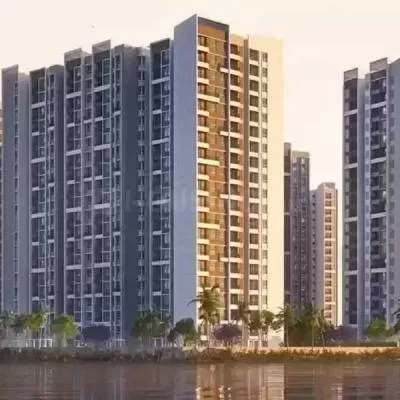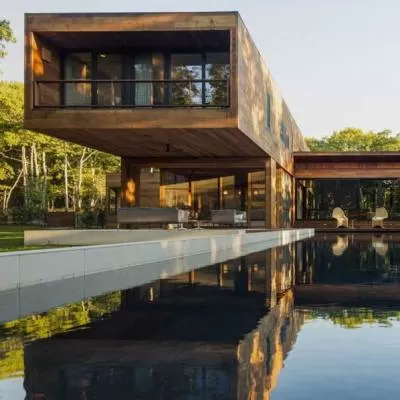- Home
- Real Estate
- Opening Opportunities

Opening Opportunities
Overall demand for UPVC shot up in 2015 to about 51,000 tonne from 34,000 tonne a year earlier. Some of this off-take has been channelled to UPVC window and door systems; clearly, demand for UPVC is charting an upward trend.
At present, however, UPVC systems enjoy only about 10-15 per cent of the windows and doors market, reckons Mahesh Londhe, Technical Head, Veka India. Meanwhile, less expensive aluminium systems have cornered 40-45 per cent of demand; wooden systems occupy 30-35 per cent of the market; and steel systems make up 8-10 per cent.
Why aluminium is in demand!
Aluminium windows typically cost Rs 200-250 per sq ft as against UPVC window systems, which start at Rs 300-350 per sq ft. According to Londhe, ´Aluminium windows are less pricy than UPVC systems because they are made of a standard metal alloy, which lends itself to limited handling - aluminium can be powder-coated or anodised. In contrast, UPVC systems come in a variety of compositions. Some profiles contain higher proportions of titanium dioxide to withstand tropical climatic conditions.´
Higher growth in the production of aluminium in India than globally and the overall low per-capita aluminium consumption figures here - 1.3 kg in India versus 12 kg in China, 28 kg in the US, 39 kg in Germany, and 7.8 kg globally - show that there is plenty of scope for growth in the uptake of aluminium systems.
´We expect between 7 per cent and 8 per cent growth in demand for aluminium fenestration systems in the next two years,´ says Rajeev Antony, Managing Director, Schueco India. ´Government impetus for growth in real-estate and the construction industry is beneficial to us; so the robust implementation of the Real-Estate Bill will boost demand for higher quality products sourced from system providers adhering to global quality standards, consistency and reliability in meeting project deadlines.´ In this segment, ´Unitised non-insulated slim aluminium façades are aesthetically pleasing and sought after for maximising views without compromising on performance parameters like wind resistance and sound insulation,´ he adds.
Choice by property segment
Decisions about the size, shape, type and characteristics of fenestration are increasingly driven not just by aesthetic concerns but demands for energy efficiency as defined by building codes, green design standards or even the building owner, says Architect Milind Pai. ´Other considerations are sustainability, durability and cost-effectiveness.´
From the perspective of durability and maintenance, the choice of materials for windows is between UPVC and aluminium, according to Kapil Brahmi, Principal Associate, CP Kukreja Architects. ´Buildings with large fenestrations are recommended in aluminium as UPVC has limitations for large areas and doesn´t support structural or curtain glazing.´
From the perspective of the housing segment, other options are available. Aluminium systems are most used for affordable housing, says Londhe. ´Low-end UPVC systems are preferred for medium segment housing, in combinations of sliding and opening profiles, while high-end residential projects typically make use of large, wider (>153 mm) frames in wooden or dark finishes with added functionality, such as tilt and slide, lift and slide. At a cost of Rs 700-1,200 per sq ft, some of these feature imported hardware.´
´Affordable units are designed with smaller fenestrations, which obviously consume less material and can even be proposed in MS tubular frames, which are less expensive than aluminium,´ says Brahmi. ´For aesthetic reasons, ultra luxury residences still prefer wood or natural substitutes to wood.´
Doors and windows for residential and commercial spaces respectively differ by design, use, function and performance. Casement systems in combinations of sliding and opening profiles are in vogue for commercial properties, adds Londhe. In commercial spaces, ´Barrier-free environments making use of glass partitions and frameless glass doors - hinged as well as sliding - are popular while wooden doors are preferred for residences,´ says Amit Bhadu, Communication and Marketing Manager, India Technal, Sapa BS India.
Single or double-glazing
Glazing has become popular for providing much desired extended views. Choosing between single or double-glazing depends on the thermal mass, quality of the double glazing and budget, says Pai. ´Double-glazing lets in as much light as single-glazing, while providing better insulation, halving the loss (or intake) of heat through the windows, thus cutting heating and cooling costs.´
Double-glazing also helps to eliminate indoor condensation - drapes on single-glazing need to be well sealed on all edges to prevent condensation - and can cut the transmission of medium to high frequencies of sound, that is voices, but not louder or lower-pitched sounds, such as traffic noise. Using thicker glass or leaving a bigger gap between the panes works best for noise reduction, although leaving a bigger gap between the panes does not help with insulation.
´Wherever possible, glazing facing the east, south and west should be double, with insulating frames and shaded,´ adds Pai.
´We recommend hermetically insulated double-glazing for its superior qualities to single-glazing,´ observes Brahmi. ´Buildings designed with this technology are considered payback sustainable, bringing in energy savings particularly when glass fenestrations cover a large area.´
Budgetary restrictions often come in the way of installing double-glazed units in affordable housing. Optimal-size solutions with single-glazed units serve the purpose of affordable housing whereas automated bigger-sized units with high-performance glazing are used in luxury housing, according to Bhadu. To cut costs, sometimes developers mix the two kinds of glazing, double to cut out noise and heat in bedrooms, single for the rest of the house, notes Londhe.
Customised solutions
Usually, developers buy pre-glazed, manufactured window units for residential projects while they get fenestration systems custom-manufactured for commercial buildings, according to Pai.
Glazed facades can be either grid curtain-walled - which involves preparing grids on site and then installing glazing - or unitised curtain-walled, which involves installing modular factory-made units. ´In India, grid curtain-walling is more popular while demand for unitised curtain-walling is increasing,´ says Bhadu. ´We offer both solutions, including customisable unitised curtain-walling systems.´
Growing awareness about customised solutions has also led to products designed specifically for the Indian market. For instance, Schueco has launched the TropTec range of products designed in Germany especially for Indian climatic and urban conditions. This is in addition to many other Schueco systems offered in India.
Medium-small fabricators can use Schueco TropTec unitised facades for being easy to fabricate, especially with sound backing from Schueco, a one-stop solution provider of systems that includes aluminium profiles, all accessories, in-depth fabrication training, software assistance and on-site interventions. With 100 new smart city projects poised to significantly increase construction opportunities and spur demand for windows and doors, new opportunities are sure to appear on the horizon.
Quick Bytes
- Smart city projects poised to spur demand for windows and doors.
- Aluminium systems majorly used for affordable housing.
- Aluminium windows cost `200-250 per sq ft; while UPVC window systems start at Rs.300-350 per sq ft.
- UPVC systems come in a variety of compositions and demand is charting an upward trend.
Focus on assembly performance
It is no longer acceptable under the codes to look at the thermal performance of just the glazing. Rather, the entire assembly including the frame, the insulated glass spacers, and the glass are as important, says Architect Milind Pai. According to Mahesh Londhe, Technical Head, Veka India, ´Very small air gaps can have a profound detrimental effect on overall window installation. Air gaps of only 1 per cent of the total window area can reduce overall potential sound insulation by as much as 10 dB, which means transmitted noises are heard twice as loud as they would be if the gaps were fully-sealed.´
- Charu Bahri
To share your views on the market for Doors & Windows in India, write in at feedback@ConstructionWorld.in
CW identifies window and door systems with the biggest potential. Overall demand for UPVC shot up in 2015 to about 51,000 tonne from 34,000 tonne a year earlier. Some of this off-take has been channelled to UPVC window and door systems; clearly, demand for UPVC is charting an upward trend. At present, however, UPVC systems enjoy only about 10-15 per cent of the windows and doors market, reckons Mahesh Londhe, Technical Head, Veka India. Meanwhile, less expensive aluminium systems have cornered 40-45 per cent of demand; wooden systems occupy 30-35 per cent of the market; and steel systems make up 8-10 per cent. Why aluminium is in demand! Aluminium windows typically cost Rs 200-250 per sq ft as against UPVC window systems, which start at Rs 300-350 per sq ft. According to Londhe, ´Aluminium windows are less pricy than UPVC systems because they are made of a standard metal alloy, which lends itself to limited handling - aluminium can be powder-coated or anodised. In contrast, UPVC systems come in a variety of compositions. Some profiles contain higher proportions of titanium dioxide to withstand tropical climatic conditions.´ Higher growth in the production of aluminium in India than globally and the overall low per-capita aluminium consumption figures here - 1.3 kg in India versus 12 kg in China, 28 kg in the US, 39 kg in Germany, and 7.8 kg globally - show that there is plenty of scope for growth in the uptake of aluminium systems. ´We expect between 7 per cent and 8 per cent growth in demand for aluminium fenestration systems in the next two years,´ says Rajeev Antony, Managing Director, Schueco India. ´Government impetus for growth in real-estate and the construction industry is beneficial to us; so the robust implementation of the Real-Estate Bill will boost demand for higher quality products sourced from system providers adhering to global quality standards, consistency and reliability in meeting project deadlines.´ In this segment, ´Unitised non-insulated slim aluminium façades are aesthetically pleasing and sought after for maximising views without compromising on performance parameters like wind resistance and sound insulation,´ he adds. Choice by property segment Decisions about the size, shape, type and characteristics of fenestration are increasingly driven not just by aesthetic concerns but demands for energy efficiency as defined by building codes, green design standards or even the building owner, says Architect Milind Pai. ´Other considerations are sustainability, durability and cost-effectiveness.´ From the perspective of durability and maintenance, the choice of materials for windows is between UPVC and aluminium, according to Kapil Brahmi, Principal Associate, CP Kukreja Architects. ´Buildings with large fenestrations are recommended in aluminium as UPVC has limitations for large areas and doesn´t support structural or curtain glazing.´ From the perspective of the housing segment, other options are available. Aluminium systems are most used for affordable housing, says Londhe. ´Low-end UPVC systems are preferred for medium segment housing, in combinations of sliding and opening profiles, while high-end residential projects typically make use of large, wider (>153 mm) frames in wooden or dark finishes with added functionality, such as tilt and slide, lift and slide. At a cost of Rs 700-1,200 per sq ft, some of these feature imported hardware.´ ´Affordable units are designed with smaller fenestrations, which obviously consume less material and can even be proposed in MS tubular frames, which are less expensive than aluminium,´ says Brahmi. ´For aesthetic reasons, ultra luxury residences still prefer wood or natural substitutes to wood.´ Doors and windows for residential and commercial spaces respectively differ by design, use, function and performance. Casement systems in combinations of sliding and opening profiles are in vogue for commercial properties, adds Londhe. In commercial spaces, ´Barrier-free environments making use of glass partitions and frameless glass doors - hinged as well as sliding - are popular while wooden doors are preferred for residences,´ says Amit Bhadu, Communication and Marketing Manager, India Technal, Sapa BS India. Single or double-glazing Glazing has become popular for providing much desired extended views. Choosing between single or double-glazing depends on the thermal mass, quality of the double glazing and budget, says Pai. ´Double-glazing lets in as much light as single-glazing, while providing better insulation, halving the loss (or intake) of heat through the windows, thus cutting heating and cooling costs.´ Double-glazing also helps to eliminate indoor condensation - drapes on single-glazing need to be well sealed on all edges to prevent condensation - and can cut the transmission of medium to high frequencies of sound, that is voices, but not louder or lower-pitched sounds, such as traffic noise. Using thicker glass or leaving a bigger gap between the panes works best for noise reduction, although leaving a bigger gap between the panes does not help with insulation. ´Wherever possible, glazing facing the east, south and west should be double, with insulating frames and shaded,´ adds Pai. ´We recommend hermetically insulated double-glazing for its superior qualities to single-glazing,´ observes Brahmi. ´Buildings designed with this technology are considered payback sustainable, bringing in energy savings particularly when glass fenestrations cover a large area.´ Budgetary restrictions often come in the way of installing double-glazed units in affordable housing. Optimal-size solutions with single-glazed units serve the purpose of affordable housing whereas automated bigger-sized units with high-performance glazing are used in luxury housing, according to Bhadu. To cut costs, sometimes developers mix the two kinds of glazing, double to cut out noise and heat in bedrooms, single for the rest of the house, notes Londhe. Customised solutions Usually, developers buy pre-glazed, manufactured window units for residential projects while they get fenestration systems custom-manufactured for commercial buildings, according to Pai. Glazed facades can be either grid curtain-walled - which involves preparing grids on site and then installing glazing - or unitised curtain-walled, which involves installing modular factory-made units. ´In India, grid curtain-walling is more popular while demand for unitised curtain-walling is increasing,´ says Bhadu. ´We offer both solutions, including customisable unitised curtain-walling systems.´ Growing awareness about customised solutions has also led to products designed specifically for the Indian market. For instance, Schueco has launched the TropTec range of products designed in Germany especially for Indian climatic and urban conditions. This is in addition to many other Schueco systems offered in India. Medium-small fabricators can use Schueco TropTec unitised facades for being easy to fabricate, especially with sound backing from Schueco, a one-stop solution provider of systems that includes aluminium profiles, all accessories, in-depth fabrication training, software assistance and on-site interventions. With 100 new smart city projects poised to significantly increase construction opportunities and spur demand for windows and doors, new opportunities are sure to appear on the horizon. Quick Bytes Smart city projects poised to spur demand for windows and doors. Aluminium systems majorly used for affordable housing. Aluminium windows cost `200-250 per sq ft; while UPVC window systems start at Rs.300-350 per sq ft. UPVC systems come in a variety of compositions and demand is charting an upward trend. Focus on assembly performance It is no longer acceptable under the codes to look at the thermal performance of just the glazing. Rather, the entire assembly including the frame, the insulated glass spacers, and the glass are as important, says Architect Milind Pai. According to Mahesh Londhe, Technical Head, Veka India, ´Very small air gaps can have a profound detrimental effect on overall window installation. Air gaps of only 1 per cent of the total window area can reduce overall potential sound insulation by as much as 10 dB, which means transmitted noises are heard twice as loud as they would be if the gaps were fully-sealed.´ - Charu Bahri To share your views on the market for Doors & Windows in India, write in at feedback@ConstructionWorld.in




















